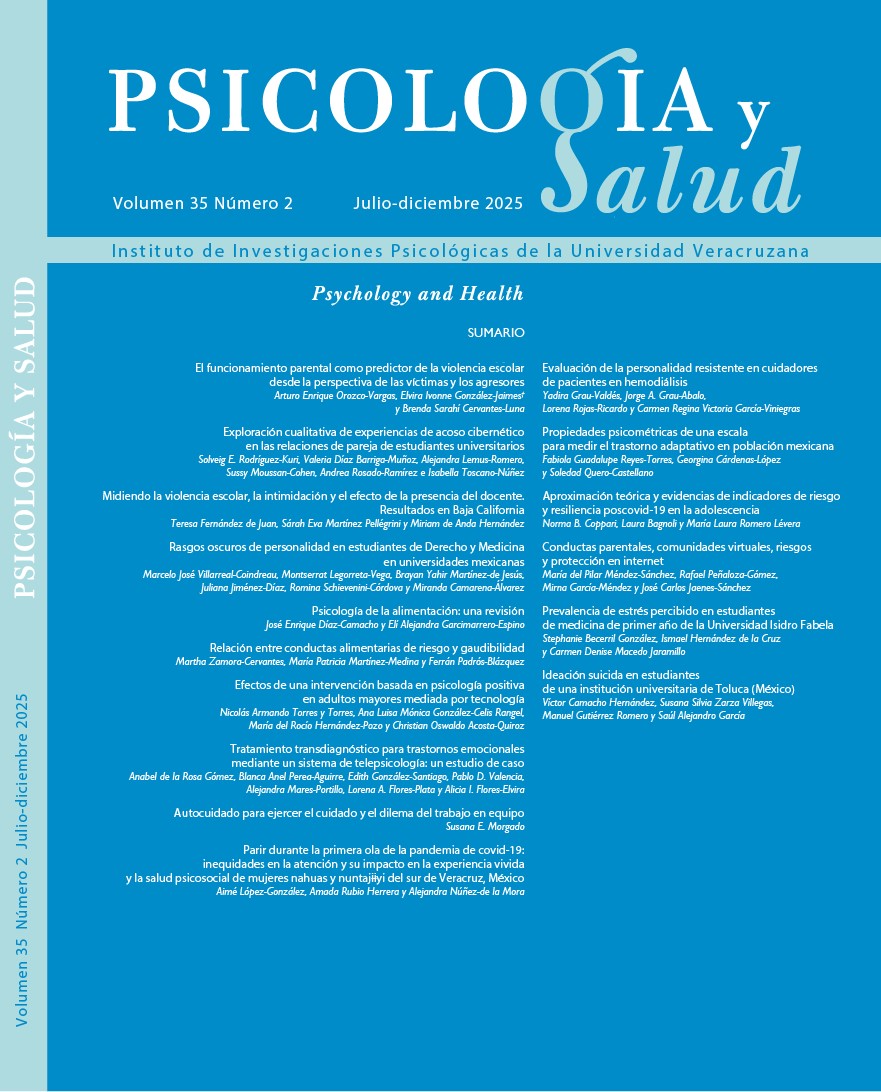Abstract
Perceived stress refers to how people perceive their environment's demands as unpredictable and uncontrollable. The present study sought to determine the prevalence, mean, and distribution of perceived stress scores among second and third-semester medical degree students by age, sex, school year, extracurricular activity, employment status, and marital status. 98 students participated in a cross-sectional study. There was an 86% response rate. Interviews registered independent variables and stress employing the Perceived Stress Scale (PSS). The mean age was 19.24 ±.93. Women comprised 62% of the participants. The prevalence of Perceived stress was 95.9%, and 27.97 ± 7.86 was the mean stress score. Women had a higher perceived stress score (29.93±7.54) compared to men (24.75±7.40) (p=0.001). No statistically significant differences resulted in mean perceived stress with the rest of the independent variables. The study concludes that perceived stress is high, and women are more likely than males to have significant perceived stress levels in their second and third semesters of medical school. These findings show the urgent need to design a university program to reduce stress by applying support strategies or extracurricular activities that promote mental health among students in the first semesters of medical school and consider women as a group at higher risk.
References
Bustamante R., De la Torre V., C.M. y Kevin, E. (2023). Relación entre el estrés y la calidad de sueño en internos de medicina humana de la ciudad del Cusco, 2023. Tesis de grado. Universidad del Cusco.
Cabanach, G., Fariña, F., Freire, C., González, P. y Del Mar F,, M. (2013). Diferencias en el afrontamiento del estrés en estudiantes universitarios hombres y mujeres. European Journal of Education and Psychology, 6(1), 19-32. Disponible en http://www.redalyc.org/articulo.oa?id=129327497002
Cabrera D., E., Charry M., S.A. y Astaiza A., G. (2023). Asociación entre depresión, ansiedad, estrés y lugar de origen (migración interna-no migración) en estudiantes universitarios. Psicología y Salud, 33(2), 477-486. Doi: 10.25009/pys.v33i2.2829
Cohen, S., Kamarck, T. y Mermelstein, R. (1983). A Global Measure of Perceived Stress. Journal of Health and Social Behavior, 24, 385-96.
Dahab, J., Rivadeneira, C. y Minici, A. (2010). Enfoque cognitivo-transaccional del estrés. CETECIC. Recuperado de https://www.cetecic.com/
García A., H.J, Hernández C., L, Och C., J.M., Cocom R., S.G. y García T., R.A. (2019). Estrés universitario en estudiantes de medicina de la Universidad de Quintana Roo. Salud Quintana-Roo, 12(41), 13-17.
Guerrero B., E. (2002). Modos de afrontamiento de estrés laboral en una muestra de docentes universitarios. Revista Interuniversitaria de Formación del Profesorado, 43, 93-112.
Jamil, Z., Baig, M., Salem, B., Mahdi, M. et al. (2018). Perceived stress, reasons for and sources of stress among medical students at Rabigh Medical College, King Abdulaziz University, Saudi Arabia. BMC Medical Education, 18(1). Doi: https://doi.org/10.1186/s1209-018-1133-2
Lemos, M., Henao, M. y López, D. (2018). Estrés y salud mental en estudiantes de medicina: relación con el afrontamiento y actividades extracurriculares. Archivos de Medicina, 14(2).
Melgosa, J. (2018). Sin estrés. Madrid: Safeliz S.L.
Meyer K., A., Ramírez F., L. y Pérez V. (2013). Percepción de estrés en estudiantes chilenos de Medicina y Enfermería. Revista de Educación en Ciencias de la Salud, 10(2), s/pp.
Molano T., N.J., Vélez T., R.A. y Rojas G., E.A. (2022). Estrés percibido durante la pandemia de covid-19 en estudiantes universitarios de Popayán (Colombia). Psicología y Salud, Núm. Esp., 82-90. Doi: 10.25009/pys.v32i3.2793
Ragga, E., Seba, M., Mohamad, H., Ahmed, M. y Tarek, S. (2012). Perceived stress and burnout among medical students during the clinical period of their education at King Faisal University, Saudi Arabia. Ibn Sina Journal of Medicine BS. Recuperado de http://www.ijmbs.org
Remor, E. (2006). Psychometric roperties of a European Spanish version of the Perceived Stress Scale (PSS). The Spanish Journal of Psychology, 9(1), 86-93.
Sánchez, J.M. (2010). Estrés laboral. Hidrogénesis, 8(2), 55-63.
Segura G., R.M. y Pérez S., I. (2016). Impacto diferencial del estrés entre hombres y mujeres: una aproximación desde el género. En UNAM. Programa Institucional de Estudios de Género de la FES Iztacala, 36.
Shah, M., Hasan, S., Malik, S. y Sreeramareddy, C. (2009). Perceived stress, sources and severity of stress among medical undergraduates in a Pakistani medical school. BMC Medical Education, 10(1). Doi: 10.1186/1472-6920-10-2


